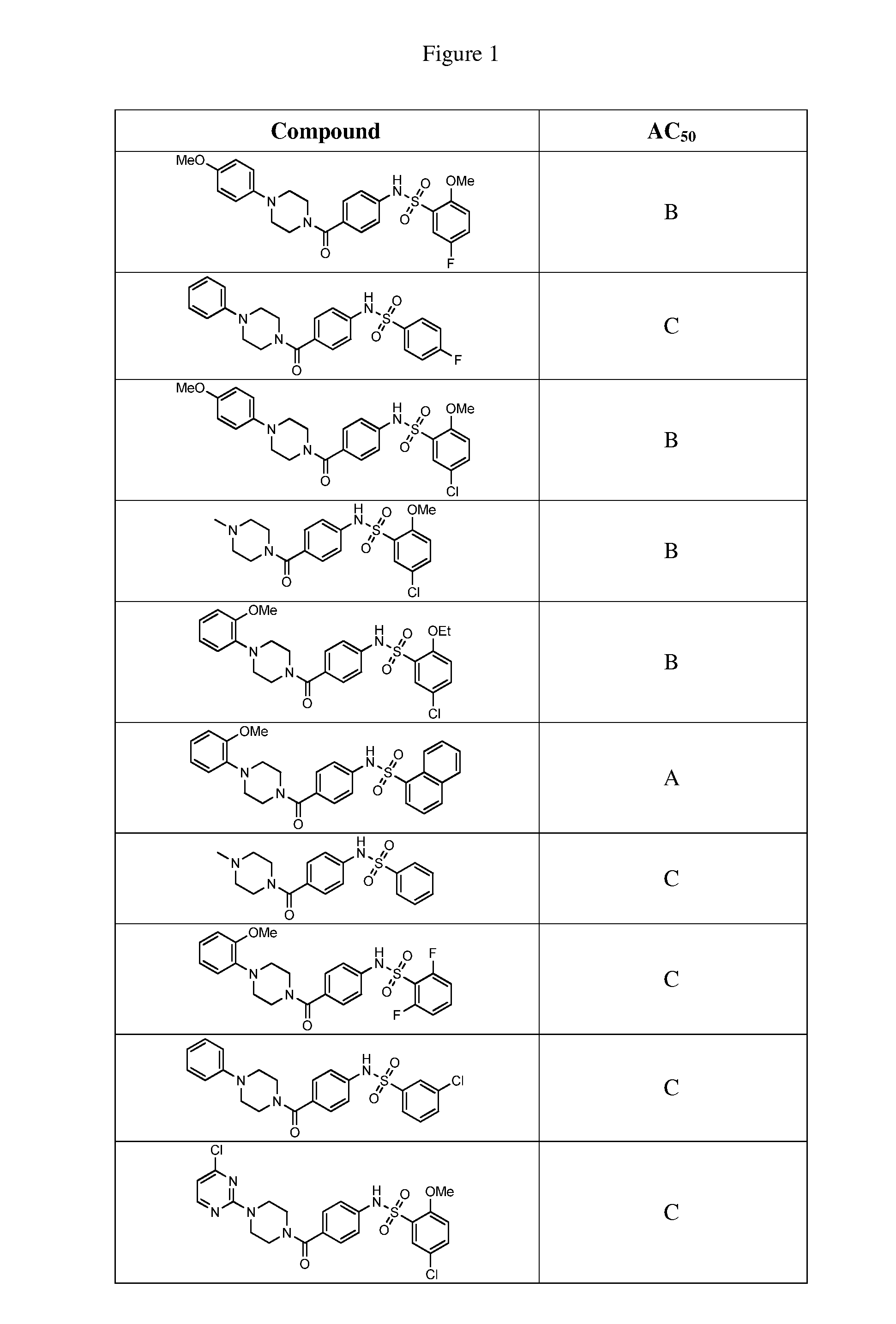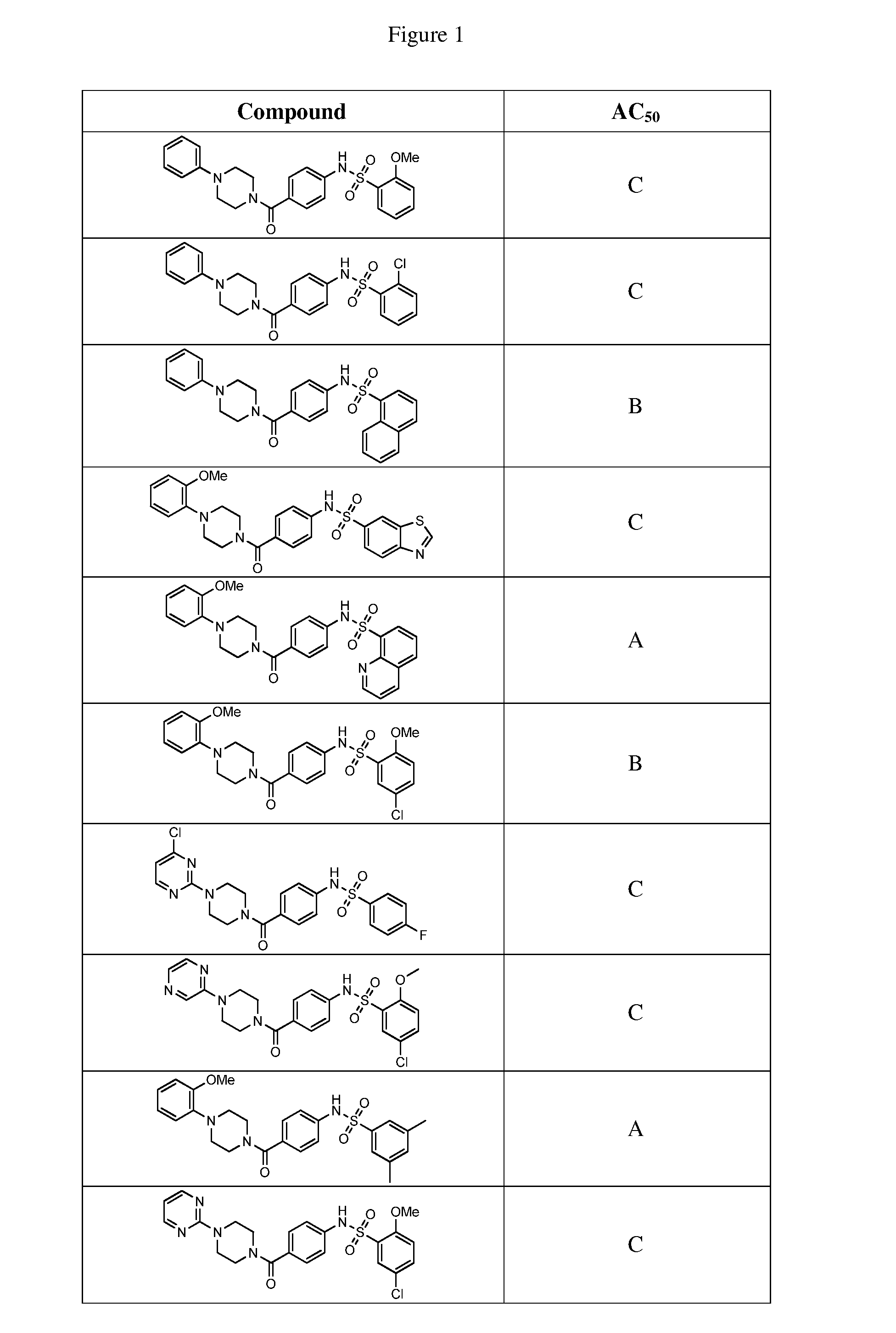Therapeutic compounds and compositions
a technology applied in the field of therapeutic compounds and compositions, can solve the problems of loss of allosteric control of pkm2, the necessary shunting biochemical intermediates, and the disease not yet exploited for therapeutic benefits, and achieve the effects of modulating (, increasing or decreasing) the level of pkm2 activity and/or glycolysis in the patient, and inhibiting cell proliferation in the patien
- Summary
- Abstract
- Description
- Claims
- Application Information
AI Technical Summary
Benefits of technology
Problems solved by technology
Method used
Image
Examples
example 1
PKM2 Assay
Procedure:
[0243]PKM2 stock enzyme solution was diluted in Reaction Buffer[0244]2 μL of compound was added into each well first, and then 180 μL of the Reaction Mix was added.[0245]Reaction mixture with compound (without ADP) were incubated for 30 minutes at 4° C.[0246]Plates were re-equilibrated to room temperature prior to adding 20 μL ADP to initiate the reaction.[0247]Reaction progress was measured as changes in absorbance at 340 nm wavelength at room temperature (25° C.)
Reaction Mix: PKM2 (50 ng / well), ADP (0.7 mM), PEP (0.15 mM), NADH (180 μM), LDH (2 units) in Reaction Buffer
Reaction Buffer: 100 mM KCl, 50 mM Tris pH 7.5, 5 mM MgCl2, 1 mM DTT, 0.03% BSA.
example 2
Compounds and Their Preparation
[0248]
[0249]General procedure for Compound 1: To a solution of 4-bromo phenol (5.0, 0.0289 moles, 1 eq) in DMF (50 mL), potassium carbonate (9.970 g, 0.0722 moles, 2.5 eq) was added followed by the addition of ethyl iodide (4.70 ml, 0.0578 moles, 2 eq) and stirred for overnight. The progress of the reaction was monitored by TLC. After completion of starting material, the reaction mixture was quenched with water (25 mL) and extracted with ethylacetate (2×50 mL). The combined organic layers were washed with brine (40 ml) solution. Ethylacetate layer was dried over Na2SO4 and concentrated under reduced pressure. The crude product was purified by column chromatography (9:1, ethyl acetate / hexane) to obtain compound 1 (5.0 g, 86.2%). MS (201.06) 202.1 (M+1).
[0250]General procedure for Compound 2: Compound 1 was taken in a two necked flask (2.00 g, 0.0099 moles, 1 eq). Chlorosulfonic acid (25 mL, 0.358 moles, 36 eq) was added slowly over a period of 10 min at...
PUM
| Property | Measurement | Unit |
|---|---|---|
| body weight | aaaaa | aaaaa |
| body weight | aaaaa | aaaaa |
| temperature | aaaaa | aaaaa |
Abstract
Description
Claims
Application Information
 Login to View More
Login to View More - R&D
- Intellectual Property
- Life Sciences
- Materials
- Tech Scout
- Unparalleled Data Quality
- Higher Quality Content
- 60% Fewer Hallucinations
Browse by: Latest US Patents, China's latest patents, Technical Efficacy Thesaurus, Application Domain, Technology Topic, Popular Technical Reports.
© 2025 PatSnap. All rights reserved.Legal|Privacy policy|Modern Slavery Act Transparency Statement|Sitemap|About US| Contact US: help@patsnap.com



